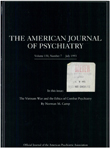Emergency psychiatric assessment of violence
Abstract
OBJECTIVE: The purpose of the study was to 1) ascertain whether there are clinical and demographic characteristics that distinguish dangerous from nondangerous patients evaluated in a psychiatric emergency service and 2) identify variables that distinguish dangerous patients who are hospitalized form those who are not. METHOD: The authors conducted a case comparison study of 99 psychiatric emergency patients whom staff identified as dangerous to others, that is, violent or potentially violent. Clinical staff were interviewed and records reviewed. These data were contrasted with record review data for 95 nondangerous patients. RESULTS: Log linear analysis showed that 1) variables relating to violence in community samples--age, sex, and past history of violence--related minimally or not at all to violence in this sample and 2) disposition to hospital versus community was associated with psychotic mental status and restraint in the psychiatric emergency service. Patients requiring restraint were more likely to have recently committed assault or battery and to have been brought in by the police. CONCLUSIONS: Enduring personal characteristics of patients relate neither to psychiatric emergency service assessments of current dangerousness nor to the decision to hospitalize. These determinations appear to be related to assessments of current patient state and immediate past behavior.
Access content
To read the fulltext, please use one of the options below to sign in or purchase access.- Personal login
- Institutional Login
- Sign in via OpenAthens
- Register for access
-
Please login/register if you wish to pair your device and check access availability.
Not a subscriber?
PsychiatryOnline subscription options offer access to the DSM-5 library, books, journals, CME, and patient resources. This all-in-one virtual library provides psychiatrists and mental health professionals with key resources for diagnosis, treatment, research, and professional development.
Need more help? PsychiatryOnline Customer Service may be reached by emailing [email protected] or by calling 800-368-5777 (in the U.S.) or 703-907-7322 (outside the U.S.).



